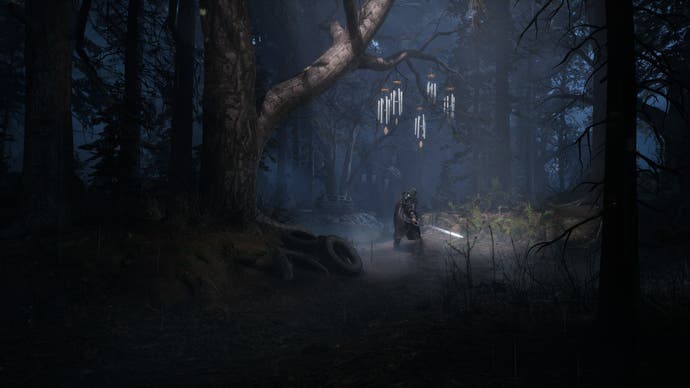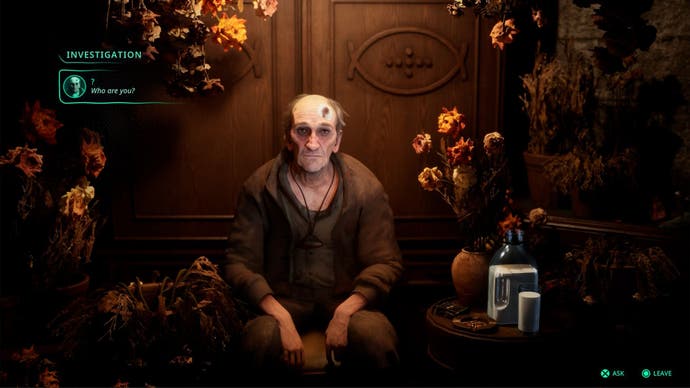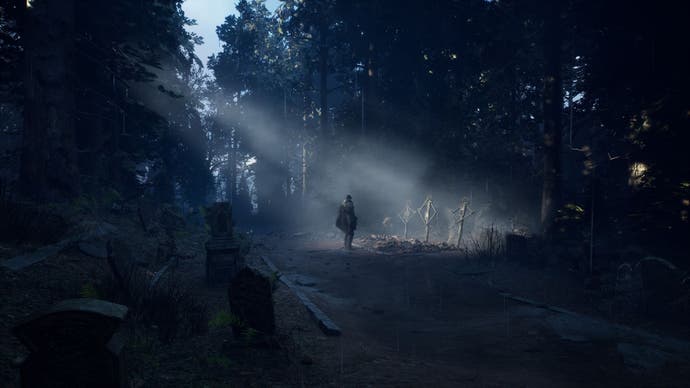Atmospheric slasher Hell is Us abandons maps and quest markers, and channels brilliant immersion in return
GPS is banned.
Set in the early nineties, Hell is Us - the upcoming action-adventure game from developer Rogue Factor - follows Rémi on a journey to find his parents in the fictional country of Hadea. The problem? Hadea is a hermit state. The only reason why Rémi lives outside of its borders is thanks to his mother, who smuggled him out when he was five. Unfortunately, she was caught by the Hadea border control, leaving him alone and eventually entering the Canadian foster system. Her capture, and the fact that his father was a blacksmith in a village called Jova, are the only things he truly remembers from his short time in Hadea. It's due to this that Rémi, despite understanding the rationality behind his parents actions, wants to reunite with them and learn exactly why they got him out.
It's a goal which becomes even more pressing when Hadea falls into a civil war. News of the war is sparse over the two years it rages thanks to Hadea's isolationist policies, but Rémi does eventually learn of a United Nations Peacekeepers mission heading into the country. Since every Hadea visa he has ever applied for has been rejected, Rémi joins the mission knowing it could be his only chance to find his family. Yet, when they arrive at the mountain range surrounding the country, the Peacekeepers are refused entry. Desperate at having come close only to be denied again, Rémi abandons his post and races down the mountainside into Hadea.
This is where my Gamescom preview of Hell is Us began: in the foothills of the Hadea mountains, with Rémi standing alongside his abandoned Peacekeepers uniform. Here in the forest, Hadea feels peaceful. Water laps at the riverbank and the wind rustles through the leaves. Yet, there was also an undercurrent of unease, since the only true knowledge I had of what laid ahead was of the war.
It didn't take long for the effects of the civil war to seep in either. Not so long into my journey Rémi reached a destroyed farmhouse. Hiding in its basement sat its owner, an old man hoping that at least one of his sons may still be alive. Later on in the preview, the presence of the civil war became inescapable, with the second area being a marshland Remi had to navigate to reach a village left in ruins from the fighting. The first thing I truly encountered in this area, however, was a mass grave; bodies of citizens caught in the crossfire of a conflict they had no control over piled on top of each other under the shadow of the excavator which dug the pit they now lie in. It was a sharp contrast to the forest Rémi had first travelled through, revealing the past tranquillity to be a facade by firmly portraying what Hadea had become. For now, however, all I had was the tidbits of information the old man could share - the rough location of Jova, little details about the civil war and, most importantly, the fact there were soldiers camping in the forest. All I had to do to find them was follow the sound of wind chimes.

I mean this literally too. Hell is Us has abandoned maps and quest markers. You don't even have a compass. Instead, you navigate Hadea by gathering directions or hints about the landscape from the characters you encounter. This can come in the form of a landmark or, in this case, a sound you need to follow. Not only does it fit with the narrative of Rémi infiltrating Hadea with barely any knowledge to guide him, but it adds a layer of fear to your exploration. You truly don't know what lies ahead of you since there's nothing to outline where a cliff, crater or other dangers might lie.
At one point I walked into a pool of water thinking, because Rémi had been fine in the last one, I could trust him to survive here. He did not. Despite this accidental death, I found this form of navigation incredibly refreshing; I was constantly engaging with the world around me, rather than simply staring at a mini-map or, worse, having some hideous orange arrow dictate my journey. (I always found this kind of navigation intrusive: GPS is for cowards! And we certainly don't have massive arrows in the sky telling us where to go in real life. We're not living in a Philip K. Dick novel. Yet.)
In keeping with this form of navigation, the closest thing Hell is Us has to a quest journal is an 'Investigation' hub. Here some, but not all, of the information you've gathered is displayed mind-map-style. Anything missing? Well I guess you better remember it. The purpose this hub serves is less about recording everything you experience and more about holding some of the puzzle pieces you need to chart Rémi's next step across Hadea. Since the details it holds are sparse, it never becomes a distraction from exploring Hadea itself. Instead, you'll quickly open it to check a detail before continuing your travels using the geographical information you've been given - be it following a series of landmarks or looking for a building.

To its benefit, Hell is Us doesn't overwhelm you with either the lack of map or minimal recorded information. The opening forest area I explored has clearly been designed to ease you into this form of navigation. The forest itself is small, with the wind chimes and later paint marks you follow being close together, but still containing a reward if you decide to go exploring. It gives you a good idea of how traversing larger scale areas might work, especially if the game offers you two sets of directions to follow. Though, in these woods, there is only one destination.
In the midst of the forest, I found a wounded soldier lying outside of an entrance to what was clearly an ancient ruin. I've read enough fantasy to recognise one on sight and enough horror to know nothing good resides inside. (The soldier's eyes being gouged out was a pretty good warning too.) Venturing into its depths, I found a place which at times felt like a forgotten castle, with rooms spanned with grand pillars, and, at others, an underground prison where people were left to rot in tiny cells. Yet, it wasn't people I found down there. No, with every step Rémi took it became clear that it's not just a civil war ravaging Hadea. There's something stranger, something darker, something older than mankind walking its fields.

I'll admit the first thing I thought when I saw the supernatural creatures of Hell is Us was, 'Huh. They remind me of Control.' Yet, if Control's Hiss are a twisted version of humanity trapped inside brutalist architecture, then the creatures in the Hell is Us embrace a horrific minimalism.
At first their pure white bodies and unnatural stillness may lead you to mistake them for marble statues. That is until you notice the dark, empty, holes where a human face and torso should be. Others have nearly abandoned any sense of humanity all together with arms like flattened wings, but, always, those facial voids remain. There's a simple, yet unsettling, beauty to their design, but all illusion drops when they spot Rémi. Arms begin to jerk in an in-human fashion or a ball of energy bursts from their stomach before lunging at you like a demonic claw machine. When this happens, it's time to get slashing.

The joy of Hell is Us' combat is its ability to channel difficulty without a sense of real punishment. While I was able to pick up the basics quickly during the preview, I still had to do some experimenting whenever I encountered a new creature. I was also able to experience some of the diversity the combat system has to offer as, while Rémi first uses a sword, I soon uncovered a pair of axes. These allowed me to test out a fast-paced combat style, reliant on getting up close and personal with an enemy before quickly dodging their attacks.
Rémi is also assisted by a drone, which, during the preview, could be used to distract enemies. Its inclusion adds another aspect to your tactics since, due to its having a cooldown, you have to decide when and where to use it. The drone could divide up the battlefield at the beginning of a fight or, if you get overwhelmed, distract a foe while you draw another away to give yourself some breathing space. Sewn together, the hack-and-slash combat and tactical drone usage create battles where precision can lead to victory. Yet, no matter how much you plan ahead, there's always a risk of becoming overwhelmed and short lived.

The result, in my brief time with it at Gamescom, was that wonderful moment when you just instantly click with a game, and don't want to leave. The narrative already has me hooked - the human story of a country drowned in war, its people barely surviving, running alongside a supernatural mystery of unknown horrors emerging from the dark - while combat mechanics show excellent promise for when Hell is Us is released next year. But it's that twist on navigation that brings the real magic of a chilling atmosphere.

